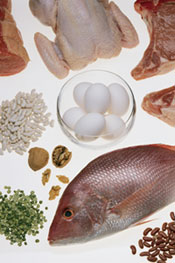|
Our Services Follow Us
Benefits of In Home Personal Training
-Personal Trainers in Maryland
-Personal Trainers in Pennsylvania
-Personal Trainers in Virginia
Every Body's Personal Trainer Accessories
Free Resources Personal Trainer/Owner Eric Leader's Blog
Company Information Every Body's Personal Trainer in the Media/Press
Physique Transformation Competition
Every Body's Personal Trainer Client Feedback
Call Now!!! (443) 615-2702 Or
Follow Us
|
Protein |
|
 What
do you think about when you hear the word protein? Maybe it's an ad for
some protein shake that promises massive muscles? Or is it the last high-protein
diet craze you read about? With all this talk about protein, you might think
Americans were at risk for not eating enough. In fact, most of us eat more
protein than we need. Protein is in many foods that we eat on a regular basis.
What
do you think about when you hear the word protein? Maybe it's an ad for
some protein shake that promises massive muscles? Or is it the last high-protein
diet craze you read about? With all this talk about protein, you might think
Americans were at risk for not eating enough. In fact, most of us eat more
protein than we need. Protein is in many foods that we eat on a regular basis.
This section will help you learn more about protein. You'll find information
about what foods have protein and what happens when we eat more protein than we
need.
What is Protein?
Proteins are part of every cell, tissue, and organ in our
bodies. These body proteins are constantly being broken down and replaced. The
protein in the foods we eat is digested into amino acids that are later used to
replace these proteins in our bodies.
Protein is found in the following foods:
| meats, poultry, and fish | |
| legumes (dry beans and peas) | |
| tofu | |
| eggs | |
| nuts and seeds | |
| milk and milk products | |
| grains, some vegetables, and some fruits (provide only small amounts of protein relative to other sources) |
As we mentioned, most adults in the United States get more than enough protein to meet their needs. It's rare for someone who is healthy and eating a varied diet to not get enough protein.
What are the types of protein?
Proteins are made up of amino acids. Think of amino acids as
the building blocks. There are 20 different amino acids that join together to
make all types of protein. Some of these amino acids can't be made by our
bodies, so these are known as essential amino acids. It's essential
that our diet provide these.
In the diet, protein sources are labeled according to how many of the essential
amino acids they provide:
| A complete protein source is one that provides all of the essential amino acids. You may also hear these sources called high quality proteins. Animal-based foods; for example, meat, poultry, fish, milk, eggs, and cheese are considered complete protein sources. |

| An incomplete protein source is one that is low in one or more of the essential amino acids. Complementary proteins are two or more incomplete protein sources that together provide adequate amounts of all the essential amino acids. |

For example, rice contains low amounts of certain essential amino acids; however, these same essential amino acids are found in greater amounts in dry beans. Similarly, dry beans contain lower amounts of other essential amino acids that can be found in larger amounts in rice. Together, these two foods can provide adequate amounts of all the essential amino acids the body needs.
| Is it true that complementary proteins must be eaten together to count as a complete protein source? |
|---|
How much protein do I need?
Maybe you've wondered how much protein you need each day. In
general, it's recommended that 10–35% of your daily calories come from protein.
Below are the Recommended Dietary Allowances (RDA) for different age groups.2
Here are examples of amounts of protein in food:
| 1 cup of milk has 8 grams of protein | |
| A 3-ounce piece of meat has about 21 grams of protein | |
| 1 cup of dry beans has about 16 grams of protein | |
| An 8-ounce container of yogurt has about 11 grams of protein |
Added together, just these four sources would meet the protein
needs of an adult male (56 grams). This doesn't count all the other foods that
add smaller amounts of protein to his diet.
Rather than just focusing on your protein needs, choose an overall healthy
eating plan that provides the protein you need as well as other nutrients.